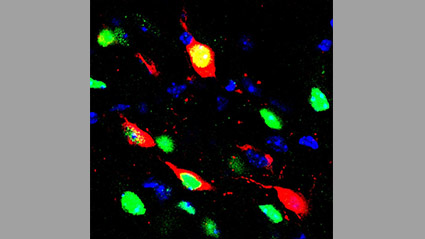Dopamine, a key component of heroin addiction

Photo illustrating dopaminergic neurons (in red). In green, are dopaminergic neurons that have been activated by heroin. In blue, a marking of the nuclei of the cells. © UNIGE
Addiction refers to the repeated and irrepressible desire to do or consume something, despite its harmful effects. This occurs when a substance or behaviour creates effects considered positive by the individuals concerned, such as pleasure or reward, which then reinforce repetitive behaviours. But, in the brain, what is going on?
By understanding the brain processes at work that lead to the powerful addictive effects of heroin, scientists at the University of Geneva (UNIGE) are helping to better understand this phenomenon. Their results, to be discovered in the journal eLife, open up new perspectives in the field of drug addiction prevention and treatment, but also in the development of non-addictive analgesic drugs.
In the brain, addiction mechanisms are born in the reward system, a set of neural networks including dopaminergic neurons whose main role is to associate certain behaviours essential to the survival of individuals - emotional ties, learning or motivation to accomplish something - with satisfaction. While this brain mechanism is essential in all mammals, it also has a darker side: addiction. This is a dysfunction of this system, where the pleasure generated by a substance or action takes precedence over any other motivation. And among addictions, the ones to heroin and other opiates appear to be particularly fast and powerful.
"While the role of the reward system in opiate addiction is now becoming well known, the exact function of the cells in it was still quite obscure." says Michaël Loureiro, post-doctoral fellow in the Department of Fundamental Neurosciences at the UNIGE Faculty of Medicine and author of this study. What about dopaminergic neurons in the specific case of opiates? "To find out, we have used advanced genetic tools - optogenetics - that allow us to selectively manipulate and observe distinct groups of neurons," continues the neuroscientist.
A direct and very fast effect of dopamine
Initially, the researchers, under the direction of Christian Lüscher, Professor in the Department of Fundamental Neurosciences at the Faculty of Medicine of the UNIGE, used a fluorescent sensor in the mouse model to measure dopamine levels in the accumbens nucleus - an area of the brain directly involved in the behaviour of the reward. Less than one minute after heroin administration, they observed a fluorescence peak representing a significant increase in dopamine. The neuroscientists then recorded the activity of mouse dopamine neurons and found that they were activated after repeated administration of heroin, confirming the previously observed dopamine release pattern.
Having established the role of dopamine, the scientists then mapped the neural signals it triggers, using two "tracers" that move to distinct regions of the brain. After heroin administration, most activated dopamine neurons send signals into the inner envelope of the accumbens nucleus, thus at the heart of the reward system. "The activation of dopaminergic neurons in the accumbens nucleus is therefore necessary for the early onset of an opioid addiction," says Dr. Loureiro.
More efficient treatments, but also less addictive analgesics
By understanding in detail the brain mechanisms underlying the strengthening of opioids and confirming the essential role played by dopaminergic neurons, UNIGE scientists are proposing a new perspective that will make it possible to refine addiction treatments. "Our study also lays the foundation for the development of pain medications that would be effective, while not having the terrible addictive power of opioids widely used today," concludes Christian Lüscher.
Author : Christian Lüscher, UNIGE >
Translation : Tania Secalin with the help of DeepL
